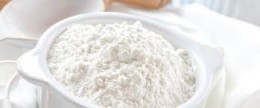White flour is common enough that you’ve probably consumed it at some point in your life. Just because it’s common, however, doesn’t mean it’s good. In fact, it has a number of downsides and negative effects on your health. Take your pick — an overall lack of nutrients, highly-refined carbohydrates, or the gluten.
What is White Flour?
White flour is wheat flour that has been stripped of two main components–the bran and the germ. The bran provides the fiber that is typically found in the whole grain, but when it is taken out of the wheat flour it creates a softer, lighter texture. This is why, if you’ve ever replaced white flour for whole-wheat flour, the final product is often heavier and denser. That’s the fiber and the added weight of the other components missing from white flour. The trouble is, the light and airy texture of the bread is fairly descriptive of its nutritional quality as well–light, airy, and vapid.
The Health Effects of White Flour
Proper nutrition plays an important role in reducing disease risk, especially when it comes to insulin resistance and type 2 diabetes. Even if you’re eating a healthy diet, however, white flour raises your risk for diabetes as well as many other preventable diseases. Research even shows that folic acid, commonly added to white flour to fortify the refined grain, can lead to deleterious effects on breast health. Our bread addiction is what is really driving disease progression in the developed world. One study has shown that even if you’re consuming a healthy diet, eating white flour can influence addictive eating behavior.
White Flour is Heavily Processed
The production of white flour involves stripping away of the most nutritional aspects of the grain: the germ and the bran. It also includes the addition of lost B vitamins and iron, and bleaching it with a chemical bleaching agent to make it appear bright white. The flour itself is devoid of the fiber which aids in passing easily through the large intestine. A person following a diet that regularly includes eating white flour as well as sugar (fructose, primarily), or products made with the ingredients, increases their chances for weight gain, insulin resistance, and type 2 diabetes. [5]
White Flour May Be Hiding in Your Wheat Bread
Wheat bread is usually touted as a more healthy alternative, but that’s little more than marketing speak at work. Most wheat breads contain “wheat” as the first ingredient; however, this term, without the “whole grain” designation preceding it, translates into refined, white flour. The color is typically added coloring to give the guise of whole wheat. Real whole wheat flour includes the terms “whole wheat flour” on both the packaging labeling and the ingredients label.
Go Wheat Free
Instead of trying to find whole wheat or whole-grain wheat, why not simply replace wheat altogether with more nutrient dense gluten-free alternatives? There are a number of alternative grains that don’t contain any gluten. And, let’s face it, gluten is a big problem and contributes to a lot of current health problems.
Do you avoid eating white flour? Wheat? What have been your experiences? Please let us know in the comments below!



